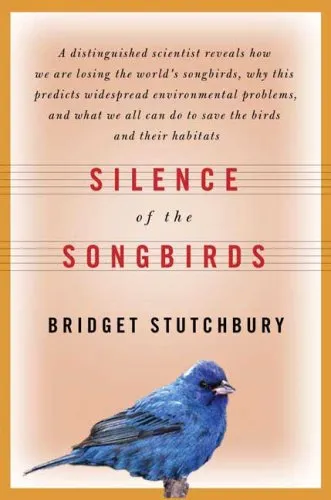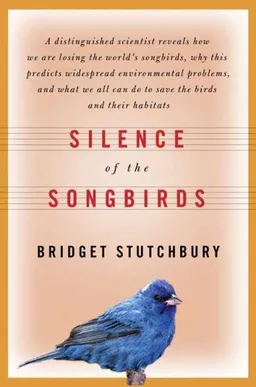Wood thrush, Kentucky warbler, the Eastern kingbird—migratory songbirds are disappearing at a frightening rate. By some estimates, we may already have lost almost half of the songbirds that filled the skies only forty years ago. Renowned biologist Bridget Stutchbury convincingly argues that songbirds truly are the “canaries in the coal mine”—except the coal mine looks a lot like Earth and we are the hapless excavators. Following the birds on their six-thousand-mile migratory journey, Stutchbury leads us on an ecological field trip to explore firsthand the major threats to songbirds: pesticides, still a major concern decades after Rachel Carson first raised the alarm; the destruction of vital habitat, from the boreal forests of Canada to the diminishing continuous forests of the United States to the grasslands of Argentina; coffee plantations, which push birds out of their forest refuges so we can have our morning fix; the bright lights and structures in our cities, which prove a minefield for migrating birds; and global warming. We could well wake up in the near future and hear no songbirds singing. But we won’t just be missing their cheery calls, we’ll be missing a vital part of our ecosystem. Without songbirds, our forests would face uncontrolled insect infestations, and our trees, flowers, and gardens would lose a crucial element in their reproductive cycle. As Stutchbury shows, saving songbirds means protecting our ecosystem and ultimately ourselves. Some of the threats to songbirds: • The U.S. annually uses 4–5 million pounds of active ingredient acephate, an insecticide that, even in small quantities, throws off the navigation systems of White-throated sparrows and other songbirds, making them unable to tell north from south. • The U.S. Fish and Wildlife Service conservatively estimated that 4–5 million birds are killed by crashing into communication towers each year.• A Michigan study found that 600 domestic cats killed more than 6,000 birds during a typical 10-week breeding season. Wood thrush, Kentucky warbler, the Eastern kingbird—migratory songbirds are disappearing at a frightening rate. By some estimates, we may already have lost almost half of the songbirds that filled the skies only forty years ago. Renowned biologist Bridget Stutchbury convincingly argues that songbirds truly are the “canaries in the coal mine”—except the coal mine looks a lot like Earth and we are the hapless excavators.
Following the birds on their six-thousand-mile migratory journey, Stutchbury leads us on an ecological field trip to explore firsthand the major threats to songbirds: pesticides, still a major concern decades after Rachel Carson first raised the alarm; the destruction of vital habitat, from the boreal forests of Canada to the diminishing continuous forests of the United States to the grasslands of Argentina; coffee plantations, which push birds out of their forest refuges so we can have our morning fix; the bright lights and structures in our cities, which prove a minefield for migrating birds; and global warming. We could well wake up in the near future and hear no songbirds singing. But we won’t just be missing their cheery calls, we’ll be missing a vital part of our ecosystem. Without songbirds, our forests would face uncontrolled insect infestations, and our trees, flowers, and gardens would lose a crucial element in their reproductive cycle. As Stutchbury shows, saving songbirds means protecting our ecosystem and ultimately ourselves.
Some of the threats to songbirds:
• The U.S. annually uses 4–5 million pounds of active ingredient acephate, an insecticide that, even in small quantities, throws off the navigation systems of White-throated sparrows and other songbirds, making them unable to tell north from south.
• The U.S. Fish and Wildlife Service conservatively estimated that 4–5 million birds are killed by crashing into communication towers each year.
• A Michigan study found that 600 domestic cats killed more than 6,000 birds during a typical 10-week breeding season. Bridget Stutchbury completed her Ph.D. at Yale University, was a research associate at the Smithsonian Institute, and is now professor of biology at York University in Toronto. She lives in Woodbridge, Ontario, and in Cambridge Springs, Pennsylvania. Wood thrush, Kentucky warbler, the Eastern kingbird—migratory songbirds are disappearing at a frightening rate. By some estimates, we may already have lost almost half of the songbirds that filled the skies only forty years ago. Renowned biologist Bridget Stutchbury convincingly argues that songbirds truly are the “canaries in the coal mine”—except the coal mine looks a lot like Earth and we are the hapless excavators.
Following the birds on their six-thousand-mile migratory journey, Stutchbury leads us on an ecological field trip to explore firsthand the major threats to songbirds: pesticides, still a major concern decades after Rachel Carson first raised the alarm; the destruction of vital habitat, from the boreal forests of Canada to the diminishing continuous forests of the United States to the grasslands of Argentina; coffee plantations, which push birds out of their forest refuges so we can have our morning fix; the bright lights and structures in our cities, which prove a minefield for migrating birds; and global warming. We could well wake up in the near future and hear no songbirds singing. But we won’t just be missing their cheery calls, we’ll be missing a vital part of our ecosystem. Without songbirds, our forests would face uncontrolled insect infestations, and our trees, flowers, and gardens would lose a crucial element in their reproductive cycle. As Stutchbury shows, saving songbirds means protecting our ecosystem and ultimately ourselves.
Some of the threats to songbirds:
• The U.S. annually uses 4–5 million pounds of active ingredient acephate, an insecticide that, even in small quantities, throws off the navigation systems of White-throated sparrows and other songbirds, making them unable to tell north from south.
• The U.S. Fish and Wildlife Service conservatively estimated that 4–5 million birds are killed by crashing into communication towers each year.
• A Michigan study found that 600 domestic cats killed more than 6,000 birds during a typical 10-week breeding season. "Important [and] enlightening...Here is an essential primer for any person who cares about our planet as a whole, or about our immediate environment. It's an eye-opener, to bird watchers, and an introduction that once again illuminates how nature is subtle beyond our humble efforts to comprehend."—Irene Wanner, San Francisco Chronicle "Few scientists know migratory birds as intimately as Bridget Stutchbury, who has followed them with wonder and passion from the jungles of Costa Rica and Belize to the hardwood forests of North America."—Scott Weidensaul, author of Living on the Wind and Return to Wild America
"Bridget Stutchbury is a leading authority on the science of migratory songbirds, but she understands the magic, too, and knows how to express it in clear, rich prose. Sil









